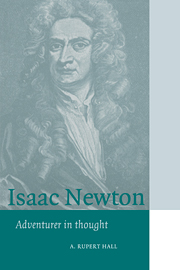Book contents
- Frontmatter
- Contents
- List of Figures
- General Editor's Preface
- Foreword
- Acknowledgement
- 1 The Hopeful Youth, 1642–1664
- 2 “The prime of my age for invention”, 1664–1667
- 3 Widening Horizons, 1667–1669
- 4 The Professor of Mathematics, 1669–1673
- 5 Publication and Polemic, 1672–1678
- 6 Life in Cambridge, 1675–1685
- 7 The Chemical Philosopher, 1669–1695
- 8 The Mathematical Principles of Natural Philosophy, 1679–1687
- 9 Private and Public life, 1685–1696
- 10 Fluxions and Fury, 1677–1712
- 11 Opticks, or a Treatise of Light, 1687–1704
- 12 Life in London, 1696–1718
- 13 A Man of Authority and Learning, 1692–1727
- 14 Later Books, 1706–1726
- 15 Kensington, 1725–1727
- Appendices
- A Newton's Alchemical Studies and his Idea of the Atomic Structure of Matter
- B Newton's Portraits
- C Newton's London Homes
- D Jonathan Swift and Catherine Barton
- E The Fate of Newton's Papers and his Library
- Notes
- Bibliography
- Index
A - Newton's Alchemical Studies and his Idea of the Atomic Structure of Matter
Published online by Cambridge University Press: 12 January 2010
- Frontmatter
- Contents
- List of Figures
- General Editor's Preface
- Foreword
- Acknowledgement
- 1 The Hopeful Youth, 1642–1664
- 2 “The prime of my age for invention”, 1664–1667
- 3 Widening Horizons, 1667–1669
- 4 The Professor of Mathematics, 1669–1673
- 5 Publication and Polemic, 1672–1678
- 6 Life in Cambridge, 1675–1685
- 7 The Chemical Philosopher, 1669–1695
- 8 The Mathematical Principles of Natural Philosophy, 1679–1687
- 9 Private and Public life, 1685–1696
- 10 Fluxions and Fury, 1677–1712
- 11 Opticks, or a Treatise of Light, 1687–1704
- 12 Life in London, 1696–1718
- 13 A Man of Authority and Learning, 1692–1727
- 14 Later Books, 1706–1726
- 15 Kensington, 1725–1727
- Appendices
- A Newton's Alchemical Studies and his Idea of the Atomic Structure of Matter
- B Newton's Portraits
- C Newton's London Homes
- D Jonathan Swift and Catherine Barton
- E The Fate of Newton's Papers and his Library
- Notes
- Bibliography
- Index
Summary
In response to my request, some years ago, Professor Karin Figala prepared an elementary account of the results of her investigation of Newton's alchemical papers and related documents. This was communicated to me privately in March 1984. In the following paragraphs Professor Figala's summary is printed, with her permission. For her technical paper on this material, see ‘Die exakte Alchemie von Isaac Newton’ in Verhandlungen der Naturforschenden Gesellschaft Basel 94, 1984, pp. 157–228.
The search for a combination of the exact sciences with magical thought was a central motive of the seventeenth-century attitude of mind: Newton was no exception to this rule. His personal attitude towards the problem is best illustrated by his (al)chemical research, for he seems to have seen in traditional alchemy – which he considered to be of divine origin – a possible synthesis of seemingly divergent lines of thought. He was convinced that God had arranged everything in Heaven and on Earth according to number and measure, thus sharing the firm belief of the ancient Pythagoreans. Harmonic proportion seems to be a key concept in Newton's thought, as mirrored in his theory of the material world. In fact, his theory of the composition of matter – laid down in principle in Opticks – centres on the material world; accordingly, contemporary alchemy immediately presented itself to his mind. It is in Newton's ‘rational alchemy’ that we can get hold of at least a small part of his attempt to reconcile magic and science.
In Newton's theory of the composition of matter, seemingly impenetrable particles are built up from cubic elementary cells, some of which hold matter, some of which do not.
- Type
- Chapter
- Information
- Isaac NewtonAdventurer in Thought, pp. 381 - 386Publisher: Cambridge University PressPrint publication year: 1996



